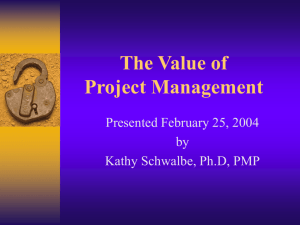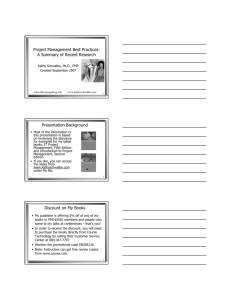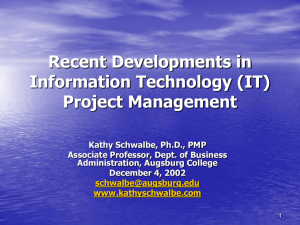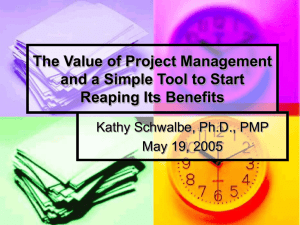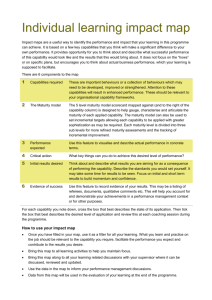The Magic of IS Project Management: Revealing the Masters* Secrets
advertisement
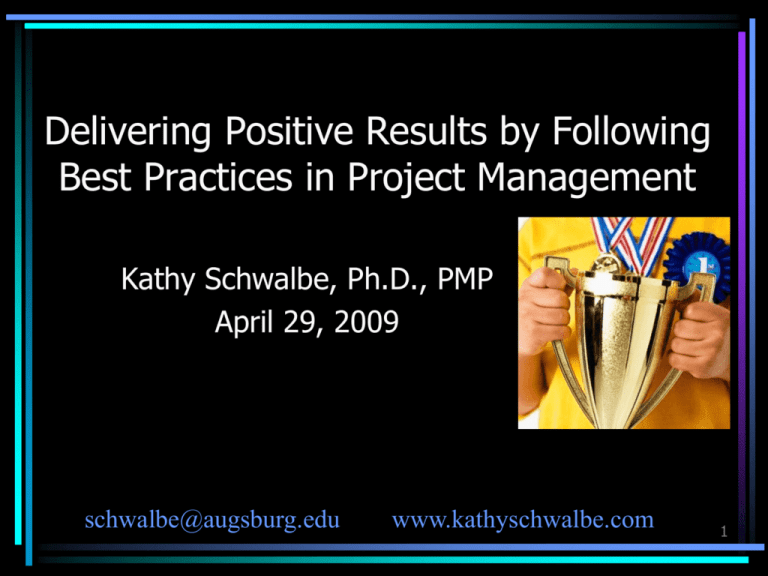
Delivering Positive Results by Following Best Practices in Project Management Kathy Schwalbe, Ph.D., PMP April 29, 2009 schwalbe@augsburg.edu www.kathyschwalbe.com 1 Presentation Background • Most of the information in this presentation is based on reviewing the literature for examples for my latest books – IT Project Management, Sixth Edition (out in April 2009) – Introduction to Project Management, Second Edition (Jan 2008) 2 Outline • What is project management (PM)? • What’s so hard about PM and using best practices? • Measuring the value of PM • Best practices for industries, organizations, and individuals • Questions/Comments 3 What Is Project Management? • Project management is “the application of knowledge, skills, tools, and techniques to project activities to meet the project requirements” (PMI, PMBOK® Guide, 2008, p. 6) • In addition to meeting project requirements, it’s also important to satisfy key stakeholders and make sure the results of the project benefit the organization 4 Project Management Framework* *From Schwalbe’s texts 5 Project Management Tools and Techniques • Project management tools and techniques assist project managers and their teams in various aspects of project management • Some specific ones include – Project charter, scope statement, and WBS (scope) – Gantt charts, network diagrams, critical path analysis, critical chain scheduling (time) – Cost estimates and earned value management (cost) – See next two slides for more 6 Common PM Tools and Techniques by Knowledge Area* *Schwalbe texts 7 Common PM Tools and Techniques by Knowledge Area (Cont’d)* * * *Schwalbe texts 8 Super Tools* • Tools already extensively used that have been found to improve project performance include: – – – – Progress reports Kick-off meetings Gantt charts Change requests • “Super tools” are those tools that have high use and high potential for improving project success, such as: – Software for task scheduling (such as project management software) – Scope statements – Requirements analyses – Lessons-learned reports *Claude Besner and Brian Hobbs, “The Perceived Value and Potential Contribution of Project 9 Research Conference Proceedings (July 2006). Management Practices to Project Success,” PMI What’s So Hard About PM and Using Best Practices? • Because every project is unique, project managers and their teams must have a good understanding of what tools and techniques are available before they can make the more difficult decisions... • ...of which ones to use on their projects and how to implement them Building Bridges-Good Procurement Management • On August 1, 2007, tragedy struck Minneapolis, Minnesota, when a bridge on I-35W collapsed, killing 13 motorists, injuring 150 people, and leaving a mass of concrete and steel in the river and on its banks* Dick Rohland, “I-35W Bridge Completion Brings Closure to Minneapolis,” ConstructionEquipmentGuide.com (October 4, 2008). 11 Continued • Peter Sanderson, PM for the joint venture of Flatiron-Manson, led his team in completing the project • The contractors earned $25 million in incentive fees on top of their $234 million contract for completing the bridge three months ahead of schedule • MnDOT justified the incentive payment by saying that each day the bridge was closed it cost road users more than $400,000 12 Winning Elections-Good Cost and Communications Management* • The Obama campaign used 16 different social platforms, including Facebook, LinkedIn, MySpace , YouTube, Fickr, Digg, Twitter, etc. to interact with people from various backgrounds • Sources say 80 percent of all contributions originated from these social networks, and some say 90 percent of all contributions (which totaled over $600 million) were less than $100 *David Krejci, “Message received,” StarTribune, Minneapolis, MN (November 5, 2008). 13 Measuring the Value of Project Management • Several studies have been done on this topic (some results follow) • Bottom line: Most people agree PM has value, but it is difficult to measure quantitatively, and what works in one organizations may not work in another! • It does help to review best practices and get ideas from others 14 Recent PMI Research Publications 15 Ways to Measure the Value of PM • • • • Agreement on general benefits Improved project performance/results ROI of project management PM maturity levels “Price is what you pay. Value is what you get.” Warren Buffet General Benefits of Project Management • Better control of financial, physical, and human resources • Improved customer relations • Shorter development times • Lower costs • Higher quality and increased reliability • Improved productivity • Better internal coordination • Higher worker morale (less stress) 2008 Research Study on the Value of PM* • Over 400-page document, free to PMI members • Most organizations (65 total in study) did see value in PM, but did not quantify it: measuring ROI “proved extremely elusive” (p. 246) • Value focused on measuring PM and – – – – satisfaction alignment process outcomes business outcomes *Janice Thomas and Mark Mullaly, “Researching the Value of Project Management,” PMI, (2008). 18 Conclusions of Study • “We are extremely comfortable stating unequivocally that project management delivers value to organizations” (p. 349) • PM value “appears to increase in proportion to the maturity of the PM implementation that is encountered... greater levels of intangible value were reported in organizations that have a higher level of maturity” (p. 352) 19 Improved Project Performance • Project success is often based on meeting project scope, time, and cost goals • The Standish Group’s CHAOS studies are well known for documenting IT project success rates and cost of failures* Measure Successful projects Failed projects Money wasted on failed and challenged projects 1994 Data 16% 31% $140 billion 2002 Data 34% 15% $55 billion 2006 Data 35% 19% $53 billion *The Standish Group International, “CHAOS Activity News,” 2(1), (2007). Why the Improvements? "The reasons for the increase in successful projects vary. First, the average cost of a project has been more than cut in half. Better tools have been created to monitor and control progress and better skilled project managers with better management processes are being used. The fact that there are processes is significant in itself.”* *The Standish Group, "CHAOS 2001: A Recipe for Success" (2001) “What the Winners Do”* • Recent research findings show that companies that excel in project delivery capability: – Build an integrated project management toolbox (use standard/advanced PM tools, lots of templates) – Grow competent project leaders, emphasizing business and soft skills – Develop streamlined, consistent project delivery processes – Install a sound but comprehensive set of project performance metrics *Dragan Milosevic, Portland State University, “Delivering Projects: What the Winners Do,” PMI Conference Proceedings ( November 2001). Findings From 5-Year Study on Quantifying the Value of PM* • • • Companies with more mature project management practices have better project performance (on time and budget vs. 40% over time and 20% over cost targets) Project management maturity is strongly correlated with more predictable project schedule and cost performance (i.e. .08 schedule performance index variation vs. .16) Good project management companies have lower direct costs than poor project management companies (6-7% vs. 11-20%) *William Ibbs and Justin Reginato, Quantifying the Value of Project Management (2002) Project Management ROI* • Over 94% of senior project management professionals say that implementing PM added value to their organizations • Formula to predict increased company ROI based on increased PMM level – Determine cost to improve PMM level, improvement in cost performance index (CPI), then calculate PM ROI using profit margins and projected annual revenues *William Ibbs, “The $$$ Value of Project Management: Continuing the Search for PM’s ROI,” PDS ’02 Conference Proceedings, PMI-ISSIG (2002). PM ROI Example* • Company initially has PMM of 2.3, CPI of .71, profit margin of 5% , $10 M projected annual revenues • Company improves PMM to 3.1, CPI to .94, profit margin to 6.6% at a cost of $400,000 • PM ROI = (6.6%-5.0%)X$10,000,000 = 40% $400,000 *William Ibbs, “Managing Chaotic Projects: Improving your PM/ROI,” (Feb. 2001). PMI’s Definition of Best Practice • A best practice is “an optimal way recognized by industry to achieve a stated goal or objective” (PMI, 2003, p. 13) • Question: Does that mean there is only one “optimum way” and that it works all the time in that industry? 26 Webster’s Definition of Best Practice • “A practice which is most appropriate under the circumstances, esp. as considered acceptable or regulated in business; a technique or methodology that, through experience and research, has reliably led to a desired or optimum result” (Webster's New Millennium™ Dictionary of English, 2007) 27 Wikipedia Definition • A best practice is “the most efficient (least amount of effort) and effective (best results) way of accomplishing a task, based on repeatable procedures that have proven themselves over time for large numbers of people...The idea is that with proper processes, checks, and testing, a desired outcome can be delivered with fewer problems and unforeseen complications” (Wikipedia, 2008) 28 Project Management Maturity Models • Similar to maturity models for improving software like the Capability Maturity Model (CMM) • Several PM firms have their own maturity models, most using levels 1-5 – The International Institute for Learning, Inc. calls the five levels common language, common processes, singular methodology, benchmarking, and continuous improvement – ESI’s five levels are called ad hoc, consistent, integrated, comprehensive, and optimizing – PMI’s Organizational Project Management Maturity Model (OPM3) released their model in 2004 PriceWaterhouseCoopers Study • Surveyed 200 companies from 30 different countries about their project management maturity and found that – Over half of all projects fail – Only 2.5% of corporations consistently meet their targets for scope, time, and cost goals for all types of projects • The survey’s main objective, however, was to investigate whether a higher maturity level would provide higher project performance PriceWaterhouseCoopers, “Boosting Business Performance through Programme and Project Management,” (June 2004). 30 More PWC Study Results • A higher maturity level for an organization enhances overall project performance, not in just one project, but in the overall portfolio of projects • Most organizations are not satisfied with their current maturity level. The total average for survey participants was 2.5 on a 5.0 scale • Project failures are often a consequence of organizational aspects over which project managers have little influence • Organizational structure has a big impact on overall project performance. The higher the alignment between structure and business requirements, the higher the overall project performance 31 More PWC Study Results - Best Practices • Staff development and professional certification enhance overall project performance. However, more than 60% of the companies surveyed do not regularly offer a development program to their project managers • A systematic approach to change management is fundamental for superior project performance • Staffing projects with a majority of internal resources as opposed to external resources is a better guarantee of success. The highest performance was achieved by using 25% external resources and 75% internal • The extent to which project management software is used is correlated to maturity levels. The lower the maturity level, the more difficulties the organization will have in implementing software 32 Another Best Practice Example Comparison of companies that performed best and worst in new product development* Best Practice Best Align projects with business strategy 65.5% Align resource breakdown with strategy 65.5% Get customer input in defining new products 69% Have an identifiable project manager 80% Worst 46% 8% 15% 50% *Robert G. Cooper, “Winning at New Products: Pathways to Profitable Intervention,” PMI Research Conference Proceedings (July 2006). 33 Best Practices of Individual Project Managers • Andy Crowe, founder and CEO of Velociteach, wrote a book in 2006 called “Alpha Project Managers: What the Top 2% Know That Everyone Else Does Not” • As the title suggests, an alpha project manager is defined as one who falls in the top two percent of project managers in terms of performance, as rated by their customers, senior managers, and team members 34 Alpha Project Managers Study Background • Crowe surveyed 860 project managers who had all been clients/students at Velociteach. • Although this was not a scientific study, the aggregate results provide interesting information that can help define best practices for project managers • The general format of the survey questions was as follows: – Mark the degree with which you agree with the following statement: Strongly disagree (0%), Somewhat disagree (20%), Neutral (50%), Somewhat agree (75%), Strongly agree (100%) 35 How the 18 Alpha PMs Differed Most • They enjoy their work more • They believe they have more authority • They believe they can have a personal impact on project success • They think it is important for the project manager to be a hands-on manager and a domain expert 36 Alpha PMs Spend Almost Twice as Much Time Planning • In fact, they spend more time in every process group than their counterparts except for execution, as follows: – Initiating: 2% vs. 1% – Planning: 21% vs. 11% – Executing: 69% vs. 82% – Controlling: 5% vs. 4% – Closing: 3% vs. 2% 37 Alpha PMs are More Efficient and Effective Communicators • When asked to rank responsiveness, the alphas’ stakeholders’ average response was 88% while the non-alpha average was only 49% • Alpha project managers send fewer emails per day and spend less time in meetings than the non-alphas • They know how to prioritize work and focus on what is most important 38 Don’t Forget This Best Practice: Take Time to Enjoy Life! 39 Questions/Comments? schwalbe@augsburg.edu www.kathyschwalbe.com 40

